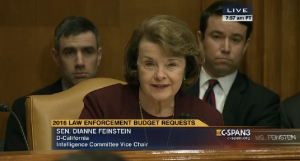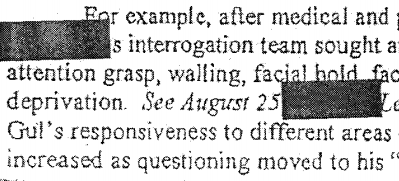The Standards for CIA Crimes
In the interest of describing why CIA’s efforts to invent a reason to torture Janat Gul are so important, I wanted to do a very quick summary of what I understand CIA’s legal means of avoiding criminal prosecution was.
Torture began — certainly at surrogates overseas — long before anyone even thought of having OLC write memos for it. At that point, the legal cover for the torture would have been only the Presidential Finding signed September 17, 2001 (which said nothing explicit about torture; but then, it probably also said nothing about killing US citizens with drones though it did cover the use of killing high value Al Qaeda figures with drones).
I believe Ali Soufan’s complaints about the methods used at the Thai black site created a problem with that arrangement. When he — an FBI Agent — came away saying what they were doing was “borderline torture,” it created legal problems for the CIA, because an FBI Agent had witnesses a crime. I think Soufan’s reaction to the coffin-like box they intended to use with Abu Zubaydah caused particular problems.
All that came to a head in July 2002, when lawyers responding to “an issue that had come up” asked for a pre-declination memo from Chertoff, even while they were trying, among other things, to get approval to use “mock burial.” I don’t know that Criminal Chief Michael Chertoff was all that squeamish about torture, except with Soufan’s complaint about the coffin, it made mock burial (and with it, I suspect, mock execution) unsupportable by DOJ.
On July 13, 2002, three things happened. John Rizzo presented the torture techniques to people at DOJ. Having had that presentation, Chertoff refused to pre-decline to prosecute. So John Yoo wrote a fax that CTC would ultimately use in crafting the legal direction to torturers (and in recommending against prosecution in the future).
Three days later, David Addington appears to have told Yoo to include presidential immunity language in more public OLC memos. All the important work was being negotiated via back channels (remember, Jay Bybee was busy protecting Cheneys’ Energy Task Force from any oversight); the front channels involving Condi Rice were in a large part show.
But that led to the position where CIA was working off a two page fax that Yoo had freelanced to produce which provided absolutely no description of or limitation on techniques. But DOJ held CIA it to the August 1, 2002 memo.
Within short order, CIA was using techniques that had never been approved. Importantly, they hosed down Gul Rahman before he froze to death, not waterboarding, per se, but an additional technique not approved by DOJ.
When Inspector General John Helgerson started investigating in early 2003, DOJ told him he could develop the fact pattern to determine if any crimes had been committed. So CTC worked with Jennifer Koester and John Yoo to develop their own legal guidelines that not only would include some more of the torture techniques they had used but not approved, but also include a “shock the conscience” analysis. That’s what the IG used to assess whether any crimes had been committed, which is important, because he found that torture as executed did humiliate detainees (and therefore violated the Constitution), but could point to (invalid) legal analysis pre-approving this. (Remember, Dick Cheney got an early review of all this.)
The problem was, DOJ’s OLC refused to accept that document. In June 2003, Patrick Philbin refused. And in May 2004, Jack Goldsmith did again.
So it was not just that Goldsmith withdrew the Bybee Memos (though said CIA could use all the torture techniques except waterboarding while he worked on a replacement). It’s that DOJ refused to accept CIA’s own legal analysis as DOJ’s official opinion. CIA was more anxious about getting some document judging the torture didn’t violate the Constitution. That’s what (as I’ll show) CIA was demanding when they raised the case of Janat Gul to get the Principals to reauthorize the use of torture in July 2004.
Just on the case of Janat Gul — who was detained based off a fabricated claim of election year plotting — CIA got OLC’s Daniel Levin to authorize all the old techniques (including waterboarding) as well as the 4 that CIA had used but not approved. Significantly, that included water dousing, the “technique” that had contributed to Gul Rahman’s death.
But that left two other concerns: the constitutional problem, and the use of techniques in combination, which (among other things) had led to severe hallucinations in 2004. That’s what the 2005 memos were meant to do: use the torture Hassan Ghul and Janat Gul had survived in 2004 to provide a rubber stamp on both the combination issue and the Constitutional one, and provide it roughly in time to be able to use to torture Abu Faraj al-Libi (though the third 2005 memo actually got signed after al-Libi’s torture began).
Neither Hassan Ghul (who was very cooperative before torture) nor Janat Gul should have been tortured. The latter probably was largely just to have one tortured body, any body, on which to hang new OLC memos.



